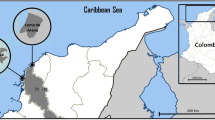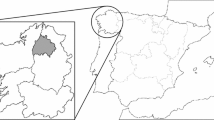Abstract
In order to biomonitor lead contamination in Southeastern Spain, 218 blood samples from 28 to 30-day old Eurasian Eagle Owl chicks (Bubo bubo) born between 2003 and 2007 were analysed. In general, mean lead levels showed that chicks were exposed to background concentrations. However, mean levels in chicks born in an ancient and abandoned mining site (“Sierra Minera Cartagena-La Union”) or in their surroundings (Geometric mean (GM) = 5.83 μg/dl, range 0.49–25.61 μg/dl), an area highly polluted by lead and other metals, were significantly higher (p < 0.001) than the rest of the population (GM = 1.66 μg/dl, range = Non detected–18.37 μg/dl). Because δ-ALAD activity is considered the best biomarker for lead exposure and effect in birds, the activity of this enzyme was also evaluated and correlated with lead levels in blood. In this study, low levels of blood lead inhibited δ-ALAD, even when lead concentrations were lower than the limits described by other authors in raptors. Adverse effects caused by this inhibition may occur when blood lead levels were above 15 μg/dl, although only eight chicks presented these concentrations in their blood. Sampling site also influenced enzymatic activity, since it decreased about 60% in the polluted area in relation to the rest. For all these reasons, further research regarding risk assessment for lead exposure in Eagle Owls nesting in the polluted area is advisable. Our results suggest that the Eurasian Eagle Owl can be considered a suitable sentinel animal for monitoring lead contamination and δ-ALAD activity can be used as a sensitive biomarker for lead exposure and effect in this species.



Similar content being viewed by others
References
Allen RL (1971) Physiology and biochemistry of the domestic fowl. Academic, New York, pp 873–881
Bechara EJ (1996) Oxidative stress in acute intermittent porphyria and lead poisoning may be triggered by 5-aminolevulinic acid. Braz J Med Biol Res 29:841–851
Becker PH (2003) Biomonitoring with birds. In: Markert BA, Breure AM, Zechmeister HG (eds) Bioindicators and biomonitors: principles, concepts, and applications. Elsevier, Oxford, pp 677–736
Benson WW, Brock DW, Gabica J, Loomis M (1976) Swan mortality due to certain heavy metals in the Mission Lake Area, Idaho. Bull Environ Contam Toxicol 15:171–174
Beyer WN, Pattee OH, Sileo L, Hoffman DJ, Mulhem BM (1985) Metal contamination in wildlife living near two Zinc smelters. Environ Pollut (Ser A) 38:63–86
Beyer WN, Spann JW, Sileo L, Franson JC (1988) Lead poisoning in six captive avian species. Arch Environ Contam Toxicol 17:121–130
Beyer WN, Dalgarn J, Dudding S, French JB, Mateo R, Miesner J, Sileo L, Spann J (2004) Zinc and lead poisoning in wild birds in the tri-state mining district (Oklahoma, Kansas, and Missouri). Arch Environ Contam Toxicol 48:108–117
Blanco G, Frías O, Jiménez B, Gómez G (2003) Factors influencing variability and potential uptake routes of heavy metals in black kites exposed to emissions from a solid-waste incinerator. Environ Toxicol Chem 22:2711–2718
BORM (2008) Orden de 11 de junio de 2008, de la Consejería de Desarrollo Sostenible y Ordenación del Territorio sobre períodos hábiles de caza para la temporada 2008/2009 en la Comunidad Autónoma de la Región de Murcia
Brace K, Altland PD (1956) Life span of the duck and chicken erythrocyte as determined with C14. Proc Soc Exp Biol Med 92:615–617
Brennan MJ, Cantrill RC (1979) Delta-aminolaevulinic acid is a potent agonist for GABA autorreceptors. Nature 280:514–515
Burger J (1995) A risk assessment for lead in birds. J Toxicol Environ Health 45:369–396
Burger J, Gochfeld M (1996) Lead and behavioral development: parental compensation for behaviorally impaired chicks. Pharm Biochem Behav 55:339–349
Burger J, Gochfeld M (1997) Age differences in metals in the blood of herring (Larus argentatus) and Franklin’s (Larus pipixcan) gulls. Arch Environ Contam Toxicol 33:436–440
Burger J, Gochfeld M (2000) Metals in albatross feathers from Midway Atoll: influence of species, age, and nest location. Environ Res A 82:207–221
Dalbeck L, Bergerhausen W, Krishner O (1998) Telemetriestudie zur Orts und Partnertreue beim Uhu Bubo bubo. Vogelwelt 119:37–344
Dieter MP, Perry MC, Mulhern BM (1976) Lead and PCBs in Canvasback Ducks: relationship between enzyme levels and residues in blood. Arch Environ Contam Toxicol 5:1–13
Eastin WC Jr, Hoffman DJ, O’Leary CT (1983) Lead accumulation and depression of δ-aminolevulinic acid dehydratase (ALAD) in young birds fed automotive waste oil. Arch Environ Contam Toxicol 12:31–35
Eisler R (2000) Handbook of chemical risk assessment: vol 1, metals. Lewis, Boca Raton
Estevan-Senís MT (1967) Explotación minera de la Sierra de Cartagena (1840–1919). Saitabi 17:211–234
Fair JM, Ricklefs RE (2002) Physiological, growth, and immune responses of Japanese quail chicks to the multiple stressors of immunological challenge and lead shot. Arch Environ Contam Toxicol 42:77–87
Franson JC (1996) Interpretation of tissue lead residues in birds other than waterfowl. In: Beyer WN, Heinz GH, Redmon-Norwood AW (eds) Environmental contaminants in wildlife: interpreting tissue concentrations. Lewis, Boca Raton, pp 265–279
Franson JC, Custer TW (1982) Toxicity of dietary lead in young cockerels. Vet Hum Toxicol 24:421–423
Franson JC, Sileo L, Pattee OH, Moore JF (1983) Effects of chronic dietary lead in American Kestrels (Falco sparverius). J Wildl Dis 19(2):110–113
Furness RW (1993) Birds as monitors of pollutants. In: Furness RW, Greenwood JJD (eds) Birds as monitors of environmental change. Champan and Hall, London, pp 86–143
García-Fernández AJ, Sánchez-García JA, Jiménez-Montalbán P, Luna A (1995) Lead and cadmium in wild birds in southeastern Spain. Environ Toxicol Chem 14(12):2049–2058
García-Fernández AJ, Motas-Guzmán M, Navas I, María-Mojica P, Luna A, Sánchez-García JA (1997) Environmental exposure and distribution of lead in four species of raptors in Southeastern Spain. Arch Environ Contam Toxicol 33:76–82
García-Fernández AJ, Romero D, Martínez-López E, Navas I, Pulido M, Maria-Mojica P (2005a) Environmental lead exposure in the European Kestrel (Falco tinnunculus) from Southeastern Spain: the influence of leaded gasoline regulations. Bull Environ Contam Toxicol 74:314–319
García-Fernández AJ, Martínez-López E, Romero D, Maria-Mojica P, Godino A, Jimenez P (2005b) High levels of blood lead in griffon vultures (Gyps fulvus) from Cazorla natural park (southern Spain). Environ Toxicol 20:459–463
Haller H (1978) Zur Populationsökologie des Uhus Bubo bubo in Hochgrebige: Bestand, Bestandesenttwickland und Lebenstaum in den Rätischen alpen. Orn Beob 75:237–365
Henny CJ, Blus LJ, Hoffman DJ, Grove RA, Hatfield JS (1991) Lead accumulation and osprey production near a mining site on the Coeur d’Alene River, Idaho. Arch Environ Contam Toxicol 21:415–424
Henny CJ, Blus LJ, Hoffman DJ, Grove RA (1994) Lead in hawks, falcons and owls downstream from a mining site on the Coeur d’Alene River, Idaho. Environ Monit Assess 29:267–288
Hoffman DJ, Pattee OH, Wiemeyer SN, Mulhern B (1981) Effects of lead shot ingestion on aminolevulinic acid dehydratase activity, hemoglobin concentration, and serum chemistry in bald eagles. J Wildl Dis 17:423–431
Hoffman DJ, Franson JC, Pattee OH, Bunck CM, Anderson A (1985a) Survival, growth and accumulation of ingested lead in nestling American Kestrels (Falco sparverius). Arch Environ Contam Toxicol 14:89–94
Hoffman DJ, Franson JC, Pattee OH, Bunck CM, Murray HC (1985b) Biochemical and hematological effects of lead ingestion in nestling American Kestrels (Falco sparverius). Comp Biochem Physiol C 80:431–439
Lawton LJ, Donaldson WE (1991) Lead-induced tissue fatty acid alterations and lipid peroxidation. Biol Trace Elem Res 28:83–97
León M, Martínez JE, Calvo JF (2008) Ecología del búho real (Bubo bubo) en el sureste de la Región de Murcia. Distribución, ocupación territorial, parámetros reproductores, dieta y mortalidad. XIX Congreso Español de Ornitología, Santander
Ma WC (1996) Lead in mammals. In: Beyer WN, Heinz GH, Redmon-Norwood AW (eds) Environmental contaminants in wildlife: interpreting tissue concentrations. Lewis, Boca Raton, pp 281–296
Martínez JE, Calvo JF (2006) Búho Real Bubo bubo (LINNAEUS, 1758). In: Robledano F, Calvo JF, Aledo E (eds) Libro Rojo de los Vertebrados de la Región de Murcia. Consejería de Industria y Medio Ambiente, Región de Murcia, pp 182–183
Martínez JA, Zuberogoitia I (2003) Búho Real Bubo bubo. In: Marti R, del Moral JC (eds) Atlas de las Aves Reproductoras de España. Dirección General de Conservación de la Naturaleza-Sociedad Española de Ornitología, Madrid, pp 316–317
Martínez-López E, María-Mojica P, Martínez JE, Peñalver J, Pulido M, Calvo JF, García-Fernández AJ (2004) Lead in feathers and δ-aminolevulinic acid dehydratase activity in three raptor species from an unpolluted mediterranean forest (Southeastern Spain). Arch Environ Contam Toxicol 47:270–275
Martínez-Sánchez MJ, Pérez-Sirvent C (2009) Análisis del estado de contaminación del suelo en el Sistema de Campo de Cartagena-Mar Menor. In: Cabezas Calvo-Rubio F (ed) El Mar Menor: Estado actual del conocimiento científico. Instituto Mediterráneo del Agua, Murcia, pp 207–243
Mateo R, Estrada J, Paquet JY, Riera X, Dominguez L, Guitart R, Martínez-Vilalta A (1999) Lead shot ingestion by marsh harriers Circus aeruginosus from the Ebro delta, Spain. Environ Pollut 104:435–440
Mateo R, Taggart M, Meharg AA (2003) Lead and arsenic in bones of birds of prey from Spain. Environ Pollut 126(1):107–114
McBride TJ, Smith JP, Gross HP, Hooper MJ (2004) Blood-lead and ALAD activity levels of Cooper’s Hawks (Accipiter cooperii) migrating through the southern Rocky Mountains. J Raptor Res 38(2):118–124
Mikkola H (1983) Owls of Europe. T. & A.D. Poyser, Calton
NRC (U.S. National Research Council) (1987) Committee on biological markers. Environ Health Perspect 74:3–9
NRC (U.S. National Research Council) (1991) Animals as sentinels of environmental health hazards. National Academy Press, Washington
Pain DJ, Rattner BA (1988) Mortality and hematology associated with the ingestion of one number four lead shot in black ducks, Anas rubripes. Bull Environ Contam Toxicol 40:159–164
Pavetti FG, Conesa-Alcaraz M, Faz-Cano A, Arnaldos R, García G (2006) Contaminación por metales pesados en la rambla de El Gorguel (SE Península Ibérica). Terra 24:171–178
Scheuhammer AM (1987a) Erythrocyte d-aminolevulinic acid dehydratase in birds. I. The effects of lead and others metals in vitro. Toxicology 45:155–163
Scheuhammer AM (1987b) Erythrocyte delta-aminolevulinic acid dehydratase in birds. II. The effects of lead exposure in vivo. Toxicology 45:165–175
Scheuhammer AM (1989) Monitoring wild bird populations for lead exposure. J Wildl Manage 53:759–765
Tejedor MC, González M (1992) Comparisons between lead levels in blood and bone tissue of rock doves (Columba livia) treated with lead acetate or exposed to the environment of Alcalá de Henares. Bull Environ Contam Toxicol 48:835–842
Tola S, Humberg S, Asp S, Nikkanen J (1973) Parameters indicative of absorption and biological effect in the new lead exposure: a perspective study. Br J Ind Med 30:134
Vanparys C, Dauwe T, van Campenhout K, Bervoets L, De Coen W, Blust R, Eens M (2008) Metallothioneins (MTs) and δ-aminolevulinic acid dehydratase (ALAd) as biomarkers of metal pollution in great tits (Parus major) along a pollution gradient. Sci Total Environ 401:184–193
Vermeulen F, D’Havéa H, Mubianaa VK, Van den Brink NW, Blusta R, Bervoetsa L, De Coen W (2009) Relevance of hair and spines of the European hedgehog (Erinaceus europaeus) as biomonitoring tissues for arsenic and metals in relation to blood. Sci Total Environ 407(5):1775–1783
Yeoman WB, Colinet F, Griepink B (1985) The certification of lead and cadmium in three lyophilized blood materials CRM 194, 195, 196. Community Bureau of Reference, Commission of the European Communities, Brussels
Acknowledgments
The authors thank MICIIN for financial support through projects CGL2004-5959/BOS and CGL2008-4318/BOS and Seneca Foundation (08758/PI/08). Special thanks to José Enrique Martínez, Francisco Botella, José Antonio Sánchez-Zapata, Eloy Pérez and José Alfonso Lacalle for sampling efforts. The sampling in Murcia was authorized by the General Directorate of Natural Patrimony and Biodiversity from the Autonomous Community of Murcia Region.
Author information
Authors and Affiliations
Corresponding author
Rights and permissions
About this article
Cite this article
Gómez-Ramírez, P., Martínez-López, E., María-Mojica, P. et al. Blood lead levels and δ-ALAD inhibition in nestlings of Eurasian Eagle Owl (Bubo bubo) to assess lead exposure associated to an abandoned mining area. Ecotoxicology 20, 131–138 (2011). https://doi.org/10.1007/s10646-010-0563-3
Accepted:
Published:
Issue Date:
DOI: https://doi.org/10.1007/s10646-010-0563-3




